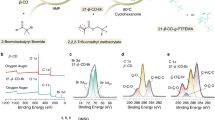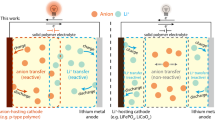Abstract
Rechargeable batteries paired with sodium metal anodes are considered to be one of the most promising high-energy and low-cost energy-storage systems. However, the use of highly reactive sodium metal and the formation of sodium dendrites during battery operation have caused safety concerns, especially when highly flammable liquid electrolytes are used. Here we design and develop solvent-free solid polymer electrolytes (SPEs) based on a perfluoropolyether-terminated polyethylene oxide (PEO)-based block copolymer for safe and stable all-solid-state sodium metal batteries. Compared with traditional PEO SPEs, our results suggest that block copolymer design allows for the formation of self-assembled nanostructures leading to high storage modulus at elevated temperatures with the PEO domains providing transport channels even at high salt concentration (ethylene oxide/sodium = 8/2). Moreover, it is demonstrated that the incorporation of perfluoropolyether segments enhances the Na+ transference number of the electrolyte to 0.46 at 80 °C and enables a stable solid electrolyte interface. The new SPE exhibits highly stable symmetric cell-cycling performance at high current density (0.5 mA cm−2 and 1.0 mAh cm−2, up to 1,000 h). Finally, the assembled all-solid-state sodium metal batteries demonstrate outstanding capacity retention, long-term charge/discharge stability (Coulombic efficiency, 99.91%; >900 cycles with Na3V2(PO4)3 cathode) and good capability with high loading NaFePO4 cathode (>1 mAh cm−2).
This is a preview of subscription content, access via your institution
Access options
Access Nature and 54 other Nature Portfolio journals
Get Nature+, our best-value online-access subscription
$29.99 / 30 days
cancel any time
Subscribe to this journal
Receive 12 print issues and online access
$259.00 per year
only $21.58 per issue
Buy this article
- Purchase on Springer Link
- Instant access to full article PDF
Prices may be subject to local taxes which are calculated during checkout






Similar content being viewed by others
Data availability
All the data supporting the findings of this work are in the paper and Supplementary Information. Additional data are available from the corresponding authors upon reasonable request. Source data are provided with this paper.
References
Zhao, Q. et al. Sodium-ion storage mechanism in triquinoxalinylene and a strategy for improving electrode stability. Energy Fuels 34, 5099–5105 (2020).
Palomares, V. et al. Na-ion batteries, recent advances and present challenges to become low cost energy storage systems. Energy Environ. Sci. 5, 5884–5901 (2012).
Cheng, X.-B., Zhang, R., Zhao, C.-Z. & Zhang, Q. Toward safe lithium metal anode in rechargeable batteries: a review. Chem. Rev. 117, 10403–10473 (2017).
Zhao, Y., Adair, K. R. & Sun, X. Recent developments and insights into the understanding of Na metal anodes for Na-metal batteries. Energy Environ. Sci. 11, 2673–2695 (2018).
Zhao, Q. et al. Tailored polyimide–graphene nanocomposite as negative electrode and reduced graphene oxide as positive electrode for flexible hybrid sodium-ion capacitors. ACS Appl. Mater. Interfaces. 10, 43730–43739 (2018).
Ellis, B. L. & Nazar, L. F. Sodium and sodium-ion energy storage batteries. Curr. Opin. Solid State Mater. Sci. 16, 168–177 (2012).
Forsyth, M., Porcarelli, L., Wang, X., Goujon, N. & Mecerreyes, D. Innovative electrolytes based on ionic liquids and polymers for next-generation solid-state batteries. Acc. Chem. Res. 52, 686–694 (2019).
Wang, X. et al. Toward high-energy-density lithium metal batteries: opportunities and challenges for solid organic electrolytes. Adv. Mater. 32, 1905219 (2020).
Mindemark, J., Lacey, M. J., Bowden, T. & Brandell, D. Beyond PEO—alternative host materials for Li+-conducting solid polymer electrolytes. Prog. Polym. Sci. 81, 114–143 (2018).
Rollo-Walker, G., Malic, N., Wang, X., Chiefari, J. & Forsyth, M. Development and progression of polymer electrolytes for batteries: influence of structure and chemistry. Polymers 13, 4127 (2021).
Liu, L. et al. In situ formation of a stable interface in solid-state batteries. ACS Energy Lett. 4, 1650–1657 (2019).
Yu, Z. et al. Molecular design for electrolyte solvents enabling energy-dense and long-cycling lithium metal batteries. Nat. Energy 5, 526–533 (2020).
Fan, X. et al. All-temperature batteries enabled by fluorinated electrolytes with non-polar solvents. Nat. Energy 4, 882–890 (2019).
Amanchukwu, C. V. et al. A new class of ionically conducting fluorinated ether electrolytes with high electrochemical stability. J. Am. Chem. Soc. 142, 7393–7403 (2020).
Suo, L. et al. Fluorine-donating electrolytes enable highly reversible 5-V-class Li metal batteries. Proc. Natl Acad. Sci. USA 115, 1156 (2018).
Richards, W. D., Miara, L. J., Wang, Y., Kim, J. C. & Ceder, G. Interface stability in solid-state batteries. Chem. Mater. 28, 266–273 (2016).
Olson, K. R. et al. Liquid perfluoropolyether electrolytes with enhanced ionic conductivity for lithium battery applications. Polymer 100, 126–133 (2016).
Qiao, L., Judez, X., Rojo, T., Armand, M. & Zhang, H. Review—polymer electrolytes for sodium batteries. J. Electrochem. Soc. 167, 070534 (2020).
Zhang, C. et al. Tuning of the aggregation behavior of fluorinated polymeric nanoparticles for improved therapeutic efficacy. ACS Nano 14, 7425–7434 (2020).
Zhang, C. et al. Integrating fluorinated polymer and manganese-layered double hydroxide nanoparticles as pH-activated 19F MRI agents for specific and sensitive detection of breast cancer. Small 15, 1902309 (2019).
Tan, X. et al. Amphiphilic perfluoropolyether copolymers for the effective removal of polyfluoroalkyl substances from aqueous environments. Macromolecules 54, 3447–3457 (2021).
Zhang, C. et al. Biological utility of fluorinated compounds: from materials design to molecular imaging, therapeutics and environmental remediation. Chem. Rev. 122, 167–208 (2022).
Zhang, C. et al. PFPE-based polymeric 19F MRI agents: a new class of contrast agents with outstanding sensitivity. Macromolecules 50, 5953–5963 (2017).
Li, T., Zhang, X.-Q., Shi, P. & Zhang, Q. Fluorinated solid-electrolyte interphase in high-voltage lithium metal batteries. Joule 3, 2647–2661 (2019).
Wang, X. et al. Poly(ionic liquid)s-in-salt electrolytes with co-coordination-assisted lithium-ion transport for safe batteries. Joule 3, 2687–2702 (2019).
Girard, G. M. A. et al. Sustainable, dendrite free lithium-metal electrode cycling achieved with polymer composite electrolytes based on a poly(ionic liquid) host. Batter. Supercaps 2, 229–239 (2019).
Wang, X. et al. Preparation and characterization of gel polymer electrolytes using poly(ionic liquids) and high lithium salt concentration ionic liquids. J. Mater. Chem. A 5, 23844–23852 (2017).
Stolwijk, N. A. et al. Salt-concentration dependence of the glass transition temperature in PEO–NaI and PEO–LiTFSI polymer electrolytes. Macromolecules 46, 8580–8588 (2013).
Kinsey, T., Glynn, K., Cosby, T., Iacob, C. & Sangoro, J. Ion dynamics of monomeric ionic liquids polymerized in situ within silica nanopores. ACS Appl. Mater. Interfaces 12, 44325–44334 (2020).
Kipnusu, W. K., Elmahdy, M. M., Elsayed, M., Krause-Rehberg, R. & Kremer, F. Counterbalance between surface and confinement effects as studied for amino-terminated poly(propylene glycol) constraint in silica nanopores. Macromolecules 52, 1864–1873 (2019).
Yu, Z. et al. A dynamic, electrolyte-blocking, and single-ion-conductive network for stable lithium-metal anodes. Joule 3, 2761–2776 (2019).
Zhang, C. et al. Emergence of hexagonally close-packed spheres in linear block copolymer melts. J. Am. Chem. Soc. 143, 14106–14114 (2021).
Barbon, S. M. et al. Architecture effects in complex spherical assemblies of (AB)n-type block copolymers. ACS Macro Lett. 9, 1745–1752 (2020).
Bates, M. W. et al. Synthesis and self-assembly of ABn miktoarm star polymers. ACS Macro Lett. 9, 396–403 (2020).
Zhang, C. et al. Rapid generation of block copolymer libraries using automated chromatographic separation. J. Am. Chem. Soc. 142, 9843–9849 (2020).
Min, J., Barpuzary, D., Ham, H., Kang, G. C. & Park, M. J. Charged block copolymers: from fundamentals to electromechanical applications. Acc. Chem. Res. 54, 4024–4035 (2021).
Wong, D. H. C. et al. Nonflammable perfluoropolyether-based electrolytes for lithium batteries. Proc. Natl Acad. Sci. USA 111, 3327–3331 (2014).
Tian, Y. et al. Reactivity-guided interface design in Na metal solid-state batteries. Joule 3, 1037–1050 (2019).
Cong, L. et al. Role of perfluoropolyether-based electrolytes in lithium metal batteries: implication for suppressed Al current collector corrosion and the stability of Li metal/electrolytes interfaces. J. Power Sources 380, 115–125 (2018).
Zheng, Q., Ma, L., Khurana, R., Archer, L. A. & Coates, G. W. Structure–property study of cross-linked hydrocarbon/poly(ethylene oxide) electrolytes with superior conductivity and dendrite resistance. Chem. Sci. 7, 6832–6838 (2016).
Arkhipova, E. A., Ivanov, A. S., Maslakov, K. I., Savilov, S. V. & Lunin, V. V. Effect of cation structure of tetraalkylammonium- and imidazolium-based ionic liquids on their conductivity. Electrochim. Acta 297, 842–849 (2019).
Pathirana, T., Kerr, R., Forsyth, M. & Howlett, P. C. Electrochemical formation in super-concentrated phosphonium based ionic liquid electrolyte using symmetric Li-metal coin cells. J. Electrochem. Soc. 167, 120526 (2020).
Xiang, Y. et al. Visualizing the growth process of sodium microstructures in sodium batteries by in-situ 23Na MRI and NMR spectroscopy. Nat. Nanotechnol. 15, 883–890 (2020).
Chen, J. et al. Electrolyte design for LiF-rich solid–electrolyte interfaces to enable high-performance microsized alloy anodes for batteries. Nat. Energy 5, 386–397 (2020).
Wang, Q. et al. Stabilizing a sodium-metal battery with the synergy effects of a sodiophilic matrix and fluorine-rich interface. J. Mater. Chem. A 7, 24857–24867 (2019).
Xu, M. et al. NaF-rich solid electrolyte interphase for dendrite-free sodium metal batteries. Energy Storage Mater. 44, 477–486 (2022).
Xiao, Y., Hwang, J.-Y., Belharouak, I. & Sun, Y.-K. Na storage capability investigation of a carbon nanotube-encapsulated Fe1–xS composite. ACS Energy Lett. 2, 364–372 (2017).
Zhang, J.-N. et al. Dynamic evolution of cathode electrolyte interphase (CEI) on high voltage LiCoO2 cathode and its interaction with Li anode. Energy Storage Mater. 14, 1–7 (2018).
Wang, X. et al. Poly(ionic liquid)s/electrospun nanofiber composite polymer electrolytes for high energy density and safe Li metal batteries. ACS Appl. Energy Mater. 2, 6237–6245 (2019).
Acknowledgements
The authors acknowledge the support of the Australia–India Strategic Research Fund (AISRF 48515) and the Australian Research Council for funding through the Industry Transformation Training Centre Scheme (IC180100049). The research reported here was partially supported by the National Science Foundation (NSF) through the Materials Research Science and Engineering Center at UC Santa Barbara, DMR-1720256 (IRG-2). A.K.W. and C.Z. acknowledge support from the Australian Research Council (CE140100036) and National Health and Medical Research Council for an Early Career Fellowship (APP1157440 to C.Z.). The authors acknowledge the use of the facilities and the assistance of Y. Hora at the Monash X-ray platform. The Australian National Fabrication Facility, Queensland Node, is also acknowledged for access to some items of equipment.
Author information
Authors and Affiliations
Contributions
X.W., C.Z. and M.F. conceived the idea. C.Z. designed and characterized the PFPE block polymers. C.F., Y.W. and X.T. prepared the block copolymers. X.W. led the electrolyte design, electrolyte characterization and battery experiments. T.C.M. synthesized the NFP active materials and prepared the cathodes. J.S. conducted XPS and interpreted results with C.Z. and X.W. M.S., Q.Y., F.C., D.J.S. and P.K. performed simulations and interpreted results. X.W. and C.Z. prepared the draft manuscript. P.C.H., C.J.H., A.K.W. and M.F. contributed to data interpretation and manuscript editing.
Corresponding authors
Ethics declarations
Competing interests
The authors declare no competing interests.
Peer review
Peer review information
Nature Materials thanks Shinichi Komaba and Ying Shirley Meng for their contribution to the peer review of this work.
Additional information
Publisher’s note Springer Nature remains neutral with regard to jurisdictional claims in published maps and institutional affiliations.
Supplementary information
Supplementary information
Supplementary materials, preparation and characterization, and Supplementary Figs. 1–30 and Tables 1–4.
Source data
Source Data Fig. 1
Statistical Source Data for Fig1
Source Data Fig. 2
Statistical Source Data for Fig2
Source Data Fig. 4
Statistical Source Data for Fig4
Source Data Fig. 4
Statistical Source Data for Fig4
Source Data Fig. 6
Statistical Source Data for Fig6
Rights and permissions
About this article
Cite this article
Wang, X., Zhang, C., Sawczyk, M. et al. Ultra-stable all-solid-state sodium metal batteries enabled by perfluoropolyether-based electrolytes. Nat. Mater. 21, 1057–1065 (2022). https://doi.org/10.1038/s41563-022-01296-0
Received:
Accepted:
Published:
Issue Date:
DOI: https://doi.org/10.1038/s41563-022-01296-0
This article is cited by
-
Single-phase local-high-concentration solid polymer electrolytes for lithium-metal batteries
Nature Energy (2024)
-
Challenges and prospects for room temperature solid-state sodium-sulfur batteries
Nano Research (2024)
-
Recent research trends in perfluoropolyether for energy device applications: a mini review
Journal of the Korean Ceramic Society (2024)
-
Sequencing polymers to enable solid-state lithium batteries
Nature Materials (2023)
-
Fluorination in advanced battery design
Nature Reviews Materials (2023)



